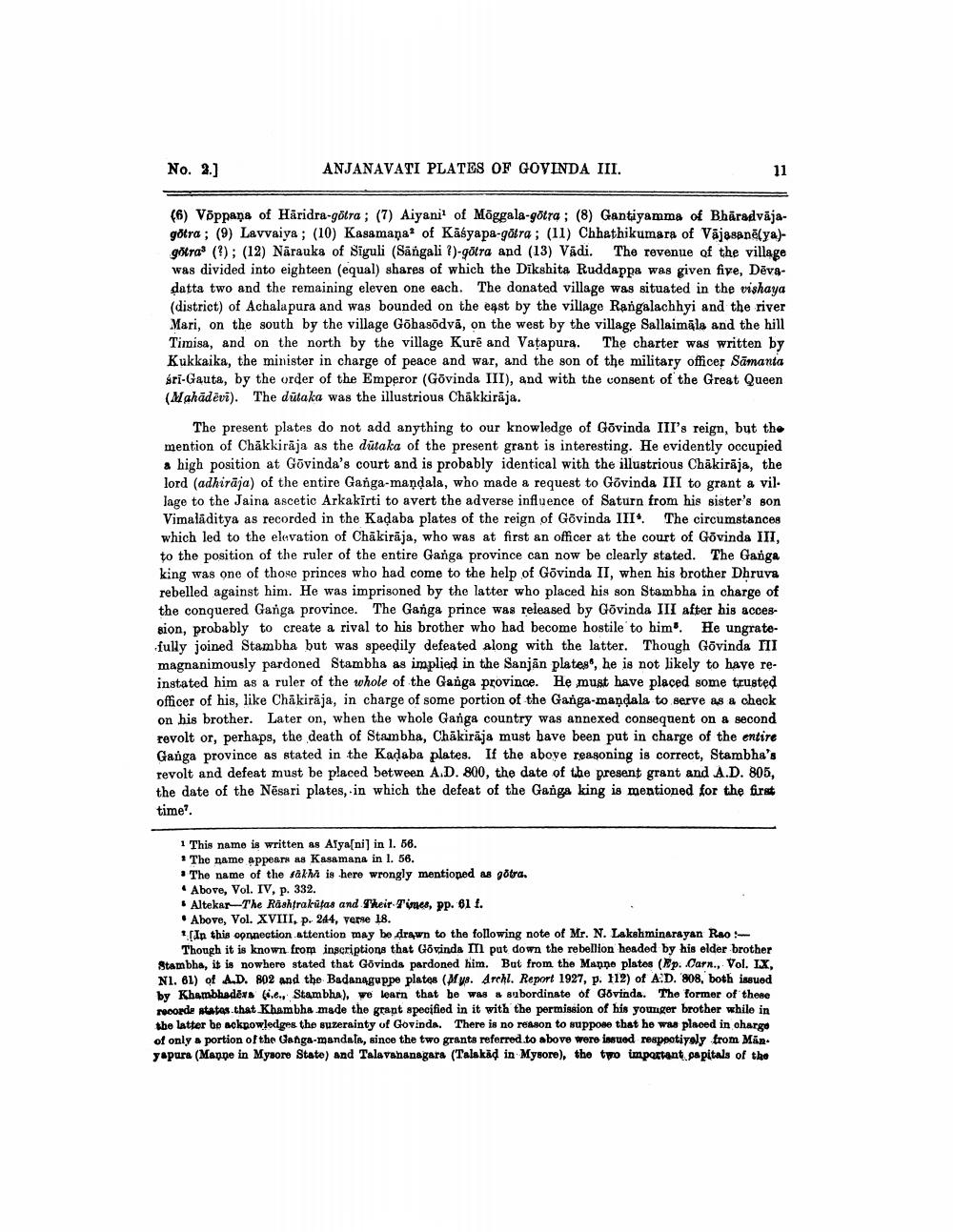________________
No. 2.]
ANJANAVATI PLATES OF GOVINDA III.
(6) Võppana of Haridra-gōtra; (7) Aiyani1 of Moggala-götra; (8) Gantiyamma of Bharadvājagötra; (9) Lavvaiya; (10) Kasamaņa of Kasyapa-gotra; (11) Chhathikumara of Vajasane(ya)gotras (?); (12) Narauka of Siguli (Sangali ?)-götra and (13) Vādi. The revenue of the village was divided into eighteen (equal) shares of which the Dikshita Ruddappa was given five, Devadatta two and the remaining eleven one each. The donated village was situated in the vishaya (district) of Achala pura and was bounded on the east by the village Rangalachhyi and the river Mari, on the south by the village Gōhasōdva, on the west by the village Sallaimala and the hill Timisa, and on the north by the village Kure and Vaṭapura. The charter was written by Kukkaika, the minister in charge of peace and war, and the son of the military officer Samanta ári-Gauta, by the order of the Emperor (Govinda III), and with the consent of the Great Queen (Mahādēvi). The dutaka was the illustrious Chakkiräja.
11
The present plates do not add anything to our knowledge of Govinda III's reign, but the mention of Chakkiraja as the dutaka of the present grant is interesting. He evidently occupied a high position at Govinda's court and is probably identical with the illustrious Chakirāja, the lord (adhiraja) of the entire Ganga-mandala, who made a request to Govinda III to grant a vil. lage to the Jaina ascetic Arkakirti to avert the adverse influence of Saturn from his sister's son Vimaladitya as recorded in the Kaḍaba plates of the reign of Govinda III. The circumstances which led to the elevation of Chakiraja, who was at first an officer at the court of Govinda III, to the position of the ruler of the entire Ganga province can now be clearly stated. The Ganga king was one of those princes who had come to the help of Govinda II, when his brother Dhruva rebelled against him. He was imprisoned by the latter who placed his son Stambha in charge of the conquered Ganga province. The Ganga prince was released by Govinda III after his accession, probably to create a rival to his brother who had become hostile to him. He ungratefully joined Stambha but was speedily defeated along with the latter. Though Govinda III magnanimously pardoned Stambha as implied in the Sanjan plates, he is not likely to have reinstated him as a ruler of the whole of the Ganga province. He must have placed some trusted officer of his, like Chakiraja, in charge of some portion of the Ganga-mandala to serve as a check on his brother. Later on, when the whole Ganga country was annexed consequent on a second revolt or, perhaps, the death of Stambha, Chakiraja must have been put in charge of the entire Ganga province as stated in the Kadaba plates. If the above reasoning is correct, Stambha's revolt and defeat must be placed between A.D. 800, the date of the present grant and A.D. 805, the date of the Nesari plates, in which the defeat of the Ganga king is mentioned for the first time".
1 This name is written as Alya[ni] in 1. 56.
The name appears as Kasamana in 1. 56.
The name of the sakhi is here wrongly mentioned as götra.
Above, Vol. IV, p. 332.
Altekar-The Rashtrakutas and Their Times, pp. 61 f.
Above, Vol. XVIII, p. 244, verse 18.
* [In this connection attention may be drawn to the following note of Mr. N. Lakshminarayan Rao :Though it is known from inscriptions that Govinda III put down the rebellion headed by his elder brother Stambha, it is nowhere stated that Govinda pardoned him. But from the Manne plates (Ep. Carn., Vol. IX, Nl. 61) of A.D. 802 and the Badanaguppe plates (Mys. Archl. Report 1927, p. 112) of A.D. 808, both issued by Khambhaders (ie., Stambha), we learn that he was a subordinate of Govinda. The former of these records states that Khambha made the grant specified in it with the permission of his younger brother while in the latter be acknowledges the suzerainty of Govinda. There is no reason to suppose that he was placed in charge of only a portion of the Ganga-mandala, since the two grants referred to above were issued respectively from Man. yapura (Mappe in Mysore State) and Talavananagara (Talakad in Mysore), the two important capitals of the




